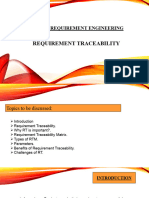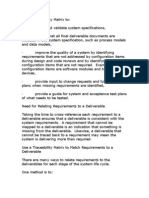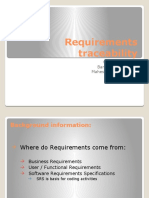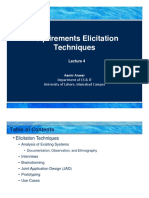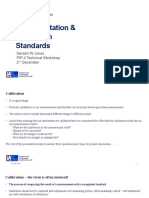0% found this document useful (0 votes)
124 views13 pagesRequirement Traceability: Aamir Anwar
The document discusses requirement traceability matrices (RTMs), which map user requirements to test cases to ensure all functionality is tested. It describes forward traceability, which maps requirements to test cases, backward traceability, which maps test cases to requirements, and bi-directional traceability. It provides steps for creating an RTM, including identifying the technical requirement and business requirement each test case verifies. The RTM links requirements at each level to demonstrate full test coverage.
Uploaded by
ShababCopyright
© © All Rights Reserved
We take content rights seriously. If you suspect this is your content, claim it here.
Available Formats
Download as PDF, TXT or read online on Scribd
0% found this document useful (0 votes)
124 views13 pagesRequirement Traceability: Aamir Anwar
The document discusses requirement traceability matrices (RTMs), which map user requirements to test cases to ensure all functionality is tested. It describes forward traceability, which maps requirements to test cases, backward traceability, which maps test cases to requirements, and bi-directional traceability. It provides steps for creating an RTM, including identifying the technical requirement and business requirement each test case verifies. The RTM links requirements at each level to demonstrate full test coverage.
Uploaded by
ShababCopyright
© © All Rights Reserved
We take content rights seriously. If you suspect this is your content, claim it here.
Available Formats
Download as PDF, TXT or read online on Scribd
/ 13







